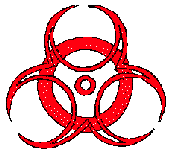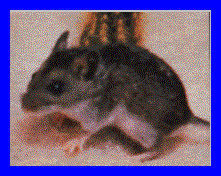


There are 3 known families of hantaviruses, however this homepage only
focuses on the Four Corners Hantavirus that causes Respiratory Distress.
Hantavirus Pulmonary Syndrome was first recognized on May 14, 1993, when
the New Mexico Office of the Medical Investigator notified the New Mexico
Department of Health of a cluster of 3 unexplained pulmonary deaths occurring in
the Four Corners region of the United States. Four Corners is so named because it
is the only place in the United States in which four states share a common border:
Utah, Arizona, New Mexico, and Colorado. On May 17, 1993, Dr. Bruce Tempest
of the Indian Health Service in Gallup, New Mexico, independently noted a cluster of
5 deaths occurring in Four Corners, and notified health authorities.
A conference was assembled among local physicians and state and federal health
authorities, even as additional cases began to be recognized. The common clinical features
among the case-patients included a prodromal illness of fever, chills, and myalgia. The
prodrome was followed by dyspnea, cough, thrombocytopenia, severe hemodynamic
instability, neutrophilia with immature forms, atypical lymphocytes, elevated serum levels
of lactate dehydrogenase. There was a high mortality rate, approximately 80 % in the
initial group of patients. The chest X-ray examinations revealed a diffuse, interstitial
infiltrate that resembled that observed in patients with adult respiratory distress syndrome
(ARDS), which is a common pattern in patients who are extremely ill from any of a
variety of diseases (e.g., bacterial sepsis or trauma). The new disease was thus called
unexplained Adult Respiratory Distress Syndrome.
Although Adult Respiratory Distress Syndrome did not feature significant renal disease, its
overall similarity to Hemorrhagic Fever with Renal Syndrome led to the inclusion of
hemorrhagic fever viruses on the short list of possible etiologies, along with a previously
unknown new virus. This concern led to the examination of serum samples from patients
with ARDS for antibodies to known agents of hemorrhagic fever. Some ARDS patients,
it was discovered, had antibodies that showed reactivity to known hantaviruses. The
pattern of reactivity, which was low titer but cross-reactive with several hantaviruses,
suggested that ARDS was caused by a novel hantavirus. When a polymerase chain reaction
assay was developed that allowed the amplification of a previously undescribed hantavirus
from the autopsied tissues of patients with ARDS, the disease was renamed Hantavirus
Pulmonary Syndrome. Rodent trapping at home sites of infected patients in Four Corners
led to the recognition that the deer mouse is the predominant host for the Four Corners virus.
This is a highly successful rodent species, with a propensity to entire human dwellings to
obtain food. The virus has been isolated from deer mice in California in 1995 and New
Mexico in 1994.

As of mid-January, 1995, Hantavirus Pulmonary Syndrome has been recognized
102 patients in 21 states of the U.S., as well as 7 in Canada and 3 in Brazil. The
overall mortality is now approximately 40%; the decline can probably be attributed
to improved fluid management in severely ill patients, and recognition of more patients
with mild disease. There remains no specific treatment, although ribavirin was used in
an uncontrolled trial without obvious success. Although the highest caseload of
Hantavirus Pulmonary Syndrome still occurs in the Four Corners states, it appears
that all states within the range of the deer mouse are susceptible to this disease.
Genetic and serologic investigations have shown that the majority, if not all, of the
case-patients who have developed Hantavirus Pulmonary Syndrome in the western
United States have been infected with the Four Corners virus.

Web Designs supplied by

Graphic Design supplied by
